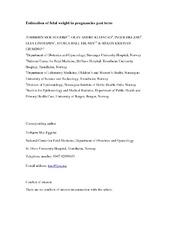Estimation of fetal weight in pregnancies past term
Eggebø, Torbjørn Moe; Klefstad, Olav-Andre; Økland, Inger; Lindtjørn, Elsa; Eik-Nes, Sturla; Gjessing, Håkon K.
Peer reviewed, Journal article
Published version

Åpne
Permanent lenke
https://hdl.handle.net/1956/18423Utgivelsesdato
2017-02Metadata
Vis full innførselSamlinger
Originalversjon
https://doi.org/10.1111/aogs.13044Sammendrag
Introduction: The aim of the study was to investigate the accuracy of estimating fetal weight with ultrasound in pregnancies past term, using the eSnurra algorithm. Material and methods: In all, 419 women with pregnancy length of 290 days, attending a specialist consultation at Stavanger University Hospital, Norway, were included in a prospective observational study. Fetal weight was estimated using biparietal diameter (BPD) and abdominal circumference (AC). The algorithm implemented in an electronic calculation (eSnurra) was used to compute estimated fetal weight (EFW). Results were compared with birthweight (BW). Results: The mean interval between the ultrasound examination and birth was 2 days (SD 1.4). The median difference between BW and EFW was −6 g (CI −40 to +25 g) and the median percentage error was –0.1% (95% CI −1.0 to 0.6%). The median absolute difference was 190 g (95% CI 170–207 g). The BW was within 10% of EFW in 83% (95% CI 79–87%) of cases and within 15% of EFW in 94% (95% CI 92–96%) of cases. Limits of agreement (95%) were from −553 g to +556 g. Using 5% false‐positive rates, the sensitivity in detecting macrosomic and small for gestational age fetuses was 54% (95% CI 35–72%) and 49% (95% CI 35–63%), respectively. Conclusion: The accuracy of fetal weight estimation was good. Clinicians should be aware of limitations related to prediction at the upper and lower end, and the importance of choosing appropriate cut‐off levels.